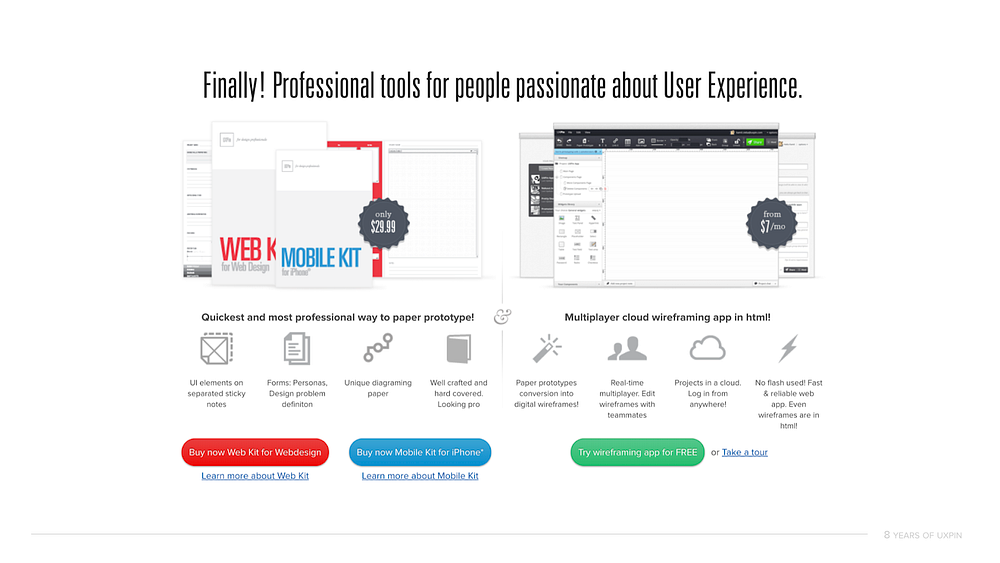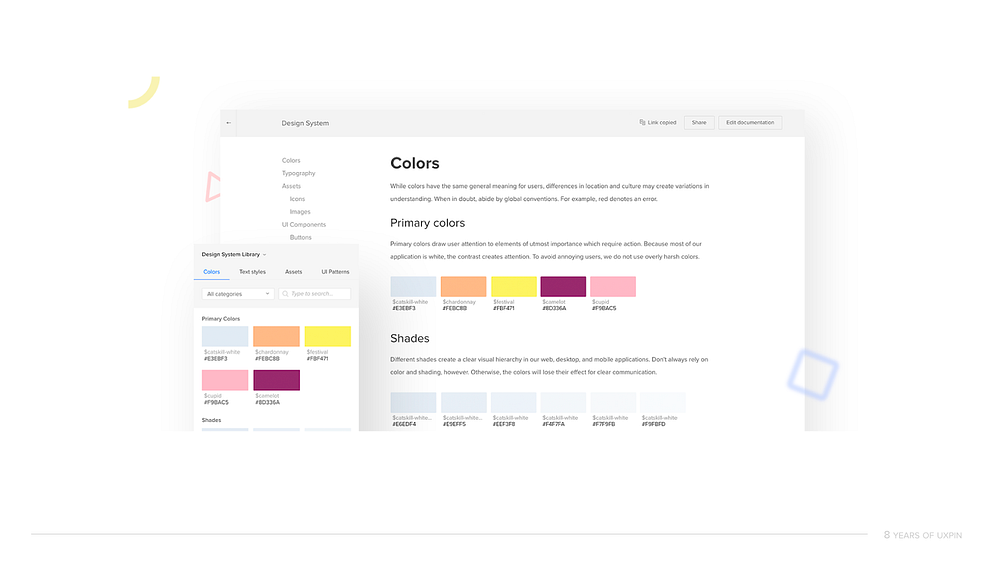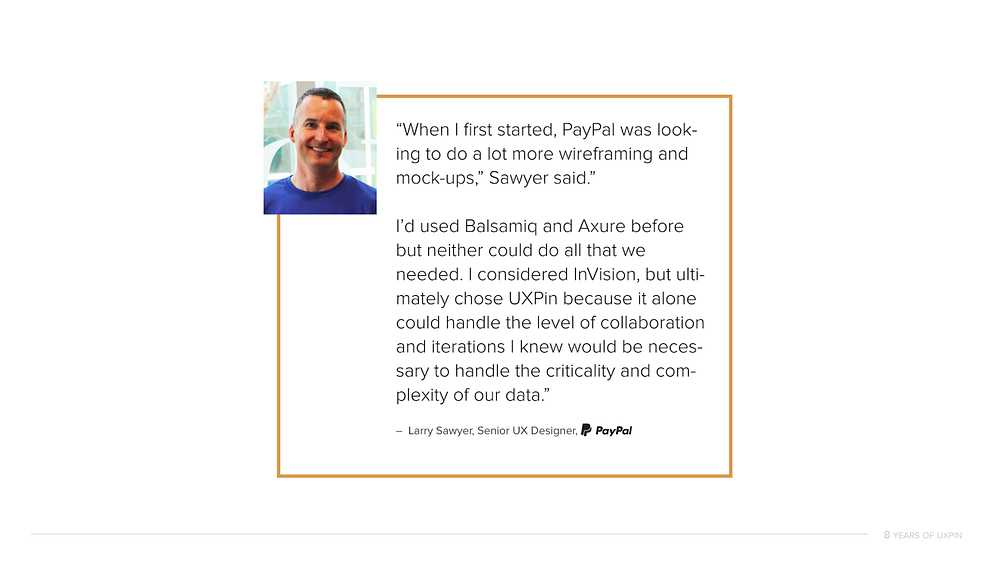UXPin’s 8th birthday this month brought on some deeply nostalgic memories.
Eight years on the design tools market has given us a pretty broad perspective. We’ve seen trends come and go, big companies enter the market and leave, companies with lots of capital doing nearly nothing and small players out–innovating everyone. One could write endlessly about it. I don’t want to bore you, so instead I’ve boiled it down to five specific lessons.
1. Being right is not enough. You have to be right at the right time.
Timing is everything. We’ve experienced it all — we’ve been too early, too late and exactly on time. Only the last group of events strongly benefits business.
Examples of being too early
The first version of UXPin had a flawless real–time collaboration (multiple people editing one design mockup simultaneously. We called it multiplayer design) in… 2011. No-one really cared about it for the first 5 years of UXPin. Only with the growth of design organizations and the expansion of remote work did real–time collaboration become truly important.
Eventually we stopped believing in multiplayer design; and this feature completely disappeared from our communication (but not from our product!). Then, a competitor announced it like it was new. Not an unrecoverable loss, but still a loss.
Another feature of our 2011 UXPin (since cancelled) was the ability to turn paper prototypes into… HTML–based prototypes. Yes. We had a technology able to transform paper prototypes into HTML… in 2011.

It was a powerful marketing machine, but with little real–life usage, we ultimately killed it in 2013. Now, 7 years later, similar products are reappearing on the market as an applauded innovation; it seems that folks are more willing to experiment with its value in real design processes. We were way, way too early.
Examples of being spot on
Back in 2015, interest grew in solutions to help organizations scale design processes without making the whole system more disjointed. The market of tools seemed almost completely empty, and customers were desperately trying to build their own solutions. We moved fast and announced Design Systems as part of UXPin before significant competitors could. First mover advantage helped us establish a solid presence on the enterprise market.

Additionally, just two weeks ago, we launched “expressions”, a feature that exposes JavaScript methods in a design tool in a friendly way — similar to Excel formulas. Expressions allow designers to create interactive prototypes with accurate simulations of, for example, form validation, eCommerce shopping carts or sign–up/sign–in flow… basically anything that is possible on the web can be accurately prototyped in UXPin.

A few years ago this feature would have been rejected in the divisive discussion, “Should designers code?” Nothing like that happened after the launch of expressions. On the contrary — the feedback was enthusiastic and we’re seeing amazing traction among both coding and non–coding designers.
2. Only achieving critical mass of value lets you escape the market’s gravity.
Sometimes it feels like a new design tool emerges every other week. After a couple of days of excitement on the market, the tool starts to fade away. 12 to 18 months later? No signs of any development.
Why?
Design tools are complicated. Hundreds of small features must exist for mass adoption of the product. Even the biggest players with the deepest pockets stumbled on this very problem, launching premature tools that, after initial excitement, got flooded with negative feedback. When folks don’t use your tool even though it’s available for free, you know something’s not working well.

I remember how surprised I was back in 2012, when some users said that they wouldn’t use UXPin until we have all the “alignment” features. As a designer, I’ve always preferred snapping and smartguides, so I didn’t see automatic alignment of elements as a key feature. And yet, to many users, it was imperative.
It took us nearly 6 years to really cover all the missing features in the product.
In the form of astrophysical paradox — a design tool only gains enough speed to escape the market’s gravity when said tool achieves the critical mass of value.
Basically, a few cool features are often enough to generate buzz, but not enough to make people switch the tool.
3. People switch tools when the perceived value is greater than the perceived cost of the switch.
Switching tools is never entirely painless. Old habits die hard; the feeling of comfort can anchor somebody to their old tool for a long time, even if (objectively) it stopped making sense quite a while ago.
And yet that anchor can be eliminated. If the perceived value exceeds the perceived cost of the switch, old habits are quickly replaced by excitement.
We see it constantly. Someone talks to us reluctantly and with a speech about the merits of their current tool. Ten minutes later, they want to strategize on how to move forward. The value of the product has to be proven, and once it is, the obstacles to growth disappear.

That said — a key moment in UXPin’s path to becoming a leader on the enterprise market was introduction of solid account management and professional services. We offer personalized help in switching from any other tool to ours.
4. Designers and engineers are ready to ditch the image–based design tool paradigm.
When working on the first software version of UXPin, we knew that in order to one day realize our mission of merging design and engineering into one unified process, we cannot follow other design tools. We couldn’t create yet another vector tool.
Vectors keep designer in the world of completely different constraints than engineers, and it’s the tip of an iceberg of problems of siloed design and engineering processes. Different visualization during the rendering process, lack of states of elements and component–level interactions in a design tool, no way to truly test highly dynamic products… the list goes on and on. Vectors were just never created to support dynamic interfaces and hence, cannot serve modern processes.
We needed to create a tool that’s fundamentally different — one that, without falling into traps of Dreamweaver and such, will have a code–based rendering engine.
Yes, UXPin, in basic design actions, may look and behave like our vector competitors. However, whenever you draw something on the screen — we build HTML and CSS behind it. When you add interactions — we create JavaScript. The goal is not to create production-ready code, it’s to keep you within the constraints of real development, while providing the realistic environment for ultra–interactive prototyping. HTML/CSS and JavaScript are all responsible for the magic of UXPin’s accurate rendering, conditional interactions, state-based animations or powerful expressions.
One after another copies of Sketch were gaining some market excitement (rarely traction) and we were wrestling with the browser and complex code.
Things started to change though. With the growth of design’s importance in software development, growth of design organizations and a constant expansion of agile methodologies, companies started to look for tools that scale with the entire product development. Those cannot be based on vectors. After all, vectors push designers to the corner of artists and engineers to the opposite one of builders. This rivalry is not the way to scale anything.
Suddenly, everyone wants a code–based tool. It just so so happens that… this is exactly what we have.
In the last 12 months, you might have noticed that we’re talking way more about our code–based nature on the market and we’re launching more and more features that take advantage of our paradigm. The best part is… those features cannot be recreated any vector tools. We’re escaping the crowd.
Among those unfeasible-for-vector-tools features is UXPin Merge — our technology that imports production React.js components to UXPin’s design editor. All data and interactions included! Merge is currently in private alpha and soon is going to be available to the general public. We could not be more excited. Watch a recording of our webinar held on December 6th.
5. Stick to your mission.
Finally, if you believe in something — stick to it. Eight years ago, there were many temptations to turn UXPin into something completely different. But we stubbornly decided to stick to our original mission of merging design and engineering into one, unified process of software development.
While more than once it seemed crazy, it paid off to be consistent.
Here’s to another 8 years of UXPin! Thank you all for your constant support. We wouldn’t be here without you!
This article was originally published here on Medium.
